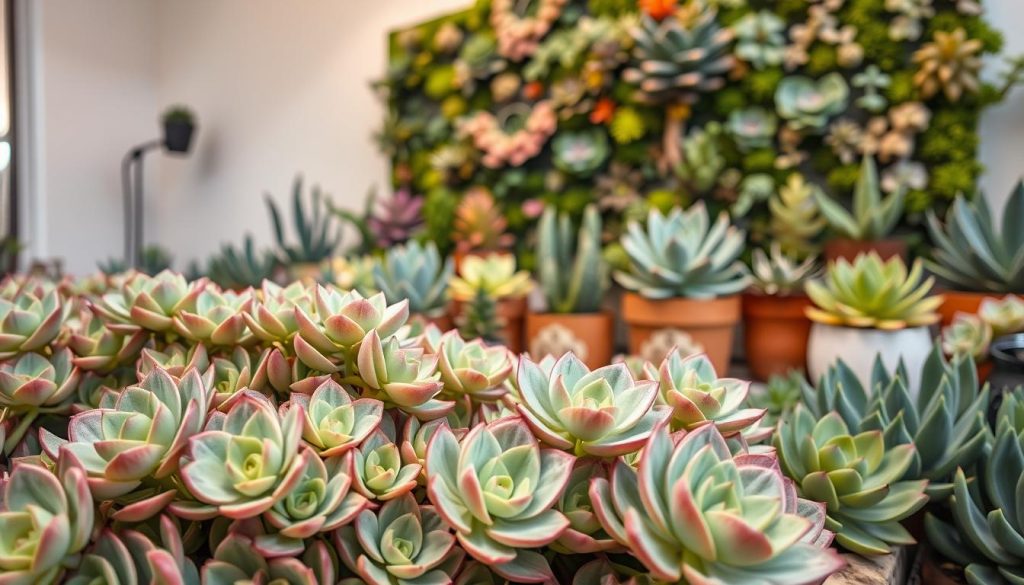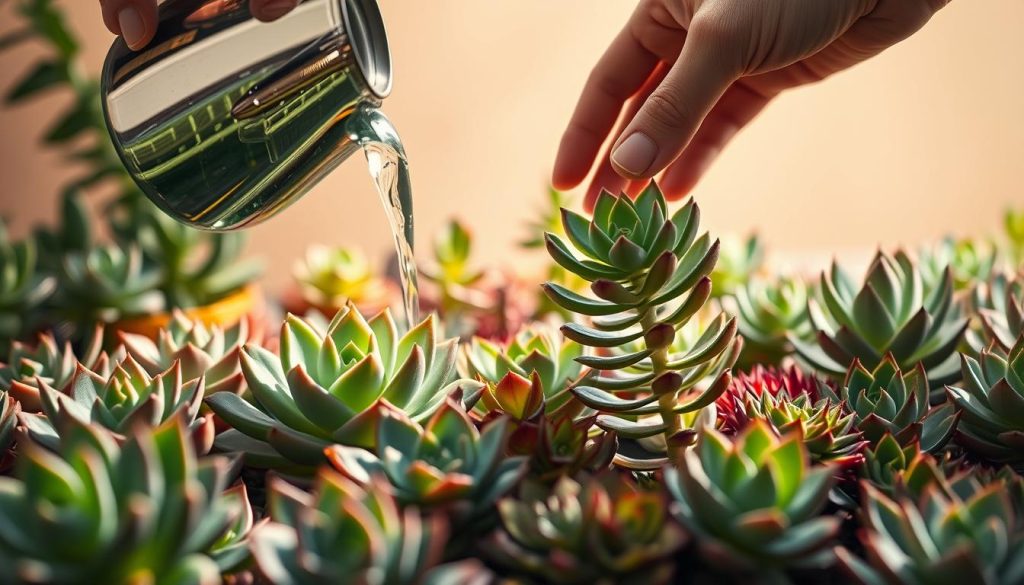Captivating Succulents for Your Home
Succulents add life to any space, whether indoors or outdoors. They have thick leaves that store water, making them tough and adaptable. This makes them perfect for different climates.
These plants are easy to care for, adding color and texture without needing constant attention. They come in all shapes and sizes, fitting any home, big or small. They’re great for all kinds of living spaces.
Key Takeaways
- Indoor succulents and outdoor succulents require fast-draining soil to stay healthy.
- They store water in leaves, needing infrequent watering to avoid rot.
- Succulents adapt to both indoor and outdoor environments with proper light and care.
- Popular types like Aloe and Echeveria add style to homes or gardens.
- Proper drainage and sunlight ensure these plants thrive with minimal effort.
Why Succulents Are the Perfect Indoor Plants
Succulents are great for busy homes or new plant owners. They need little care but add beauty to any room. This makes them perfect for today’s living spaces.
Low Maintenance Appeal
Plants like the Ponytail Palm and Hedgehog Aloe need little care. Their thick leaves and roots hold water, so they only need watering every 3–4 weeks. In winter, they need even less water, making care easier.
But, they can get too wet, so check the soil before watering. Using pots with holes helps prevent root rot.
Air-Purifying Benefits
Some succulents, like Aloe vera, clean the air and heal small burns. NASA found they release oxygen at night, helping you sleep better. They’re not just pretty; they also purify the air.
Unique Aesthetic Appeal
Succulents come in many shapes and colors. From Echeveria’s rosettes to String-of-Pearls’ trails, they fit any style. Grouping them in pots turns them into living art, enhancing any space.
Popular Types of Succulents for Beginners
Starting your succulent journey is easy. These indoor succulents need little care, perfect for beginners. Here are three easy-to-grow options that look great too.

Aloe Vera
- Scientific name: Aloe barbadensis miller
- Height: 12–36 inches
- Features: Gel inside leaves soothes burns; prefers bright, indirect light
- Tip: Water only when soil is fully dry
Jade Plant
- Scientific name: Crassula ovata
- Height: 1–3 feet indoors
- Symbolism: Believed to bring luck in many cultures
- Care: Water every 2–3 weeks; let soil dry completely
Echeveria
- Scientific name: Echeveria spp.
- Colors: Ranges from blue-green to vibrant pink
- Growth: Forms rosettes 4–8 inches wide
- Light: Direct sun enhances color; avoid overwatering
These succulent varieties are great for indoor spaces. They’re easy to care for and add beauty to your home. Make sure to use well-draining soil and place them in bright spots near windows.
Creative Ways to Display Succulents
Indoor succulents look great in creative setups that are both beautiful and useful. Whether you’re new to gardening or have lots of experience, these succulent arrangement ideas can make any space pop. Terrariums, for example, are mini worlds in glass that show off plants like String of Pearls.
For tight spots, vertical gardens are perfect. They use shelves or frames on walls to save space. This is great for plants that trail, like Burro’s Tail.
Hanging planters add a fun touch. You can use macramé hangers or old tin cans for plants like Donkey’s Tail. Grouping 2-3 small pots on windowsills creates a nice cluster. Use containers like vintage teacups or wine bottles for a unique look.
More than 25% of stylish displays feature upcycled items. This shows that old things can be really cool.
- Layered displays: Use tiered shelves or stacked crates. Place taller plants like golden barrel cactus in the back and smaller ones in front.
- Modern flair: Glass bowls or hexagonal planters add a sleek look. Driftwood and pebbles can make a natural setting.
- DIY projects: Drill holes in tins or radios to plant in. A vintage cookie tin with String of Pearls and ‘Neon’ stonecrop is a great decoration.
Even small areas can look great with shallow frames or soup ladles. Fill them with cactus soil and water carefully. For wall art, try floating shelves or clip-on hooks. Succulents need soil that’s moist but not too wet.
These indoor succulent setups fit any style, from boho to minimalist. Start with the right container and a bit of creativity. Ideas range from a radio-terrarium to a driftwood display.
Care Tips for Thriving Succulents
To keep your succulents looking their best, follow some simple care tips. Start by avoiding the mistake of overwatering. Here are the essential steps to ensure your succulents thrive.

Watering Guidelines
Learn how to water your succulents correctly:
- Water only when the top 1.25 inches of soil is dry.
- Use the “soak and dry” method: water thoroughly until drainage flows from pots with holes.
- Cut back to monthly watering in winter and increase to weekly in summer.
- Avoid misting leaves; always water soil directly.
Optimal Lighting Conditions
Most succulents need 4–6 hours of bright light daily. South-facing windows are ideal for indoor lighting. When introducing new plants to full sun, do it gradually to prevent sunburn. Variegated varieties prefer partial shade to avoid bleaching.
Soil Selection
For the best soil, ensure it drains well. Mix 1 part loam, 1 part sand, 1 part peat moss, and 1 part perlite. Commercial cactus mixes or 50/50 potting soil and pumice are also good options. Regular potting soil alone can cause rot.
Soil needs to dry completely between waterings to keep roots oxygenated. Use shallow pots with drainage holes to prevent waterlogging.
How to Propagate Succulents Easily
Learn to grow more plants from one by mastering succulent propagation. You can use leaves, stems, or offsets to create new plants. Start small and watch your collection grow with these easy steps.
Leaf Cuttings
- Select plump, healthy leaves and gently twist them from the base.
- Let cut ends dry for 3–5 days until calloused to prevent rot.
- Lay leaves on well-draining soil or water, roots will sprout in 2–3 weeks.
Offsets and Pups
- Gently pull baby plants growing at the base of the mother plant.
- Plant offsets in separate pots filled with cactus mix soil.
- Water sparingly until new growth appears.
Stem Cuttings
- Cut 2–3 inch stem sections with a clean knife.
- Set cuttings in a dry place for 3–5 days to heal.
- Plant in sandy soil or water, keeping soil moist until roots form.
Use rooting hormones like GardenTech® RootBoost™ to speed up growth. Succulent care tips after rooting include bright indirect light and infrequent watering. With patience, a single plant can multiply into dozens—perfect for gifts or expanding your garden. Always propagate during active growing seasons (spring/summer) for best results.
Common Pests and Diseases in Succulents
Even with the best care, indoor and outdoor succulents can get pests or diseases. Spotting them early and acting fast is crucial to keep your plants safe.
Identifying Common Pests
Be on the lookout for these pests:
- Mealybugs: Tiny white cottony clusters. They leave sticky residue and attract ants.
- Scale insects: Small bumps on stems causing mold growth.
- Fungus gnats: Larvae feed on roots, often in overwatered soil.
- Spider mites: Tiny red pests leaving webbing and brown spots. Thrive in dry indoor conditions.
- Aphids: Cluster on new growth, spreading diseases.
Treatment and Prevention
Here’s how to fight off pests:
- 70% isopropyl alcohol sprayed directly on pests.
- Systemic insecticides like imidacloprid for persistent cases.
- Yellow sticky traps for fungus gnats.
- High-pressure water sprays for aphids.
To stop pests, quarantine new plants and don’t overwater. For indoor plants, make sure there’s good air flow. Outdoor plants do well with diatomaceous earth to keep snails away.
When to Seek Professional Help
Call for help if:
- Pests keep coming back after 2-3 treatments.
- Plants show severe wilting or rot (black/brown tissues with odor).
- Pests like root mealybugs cause irreversible root rot.
If you have pets, choose safe treatments. Some succulents, like jade plants, are toxic and need extra care around animals.
Decorating with Succulents
Make any room stunning with succulent arrangement ideas that are both beautiful and easy to care for. Indoor succulents can transform any space. Pick plants that match your style, whether you like modern or natural looks.
Complementing Your Interior Design
Choose plants that fit your home’s style. For a minimalist look, use small pots with plants like Haworthias or Echeverias. Bohemian spaces look great with terracotta pots and String of Pearls.
Find unique containers like teacups or seashells for a quirky touch. Use colors wisely: cool greens for calm, warm tones like red-tipped Echeverias for boldness.
Seasonal Arrangements
- Autumn: Mix orange and burgundy succulents in a terra cotta bowl with cinnamon sticks.
- Winter holidays: Group jade plants with pinecones and twine for luck.
- Spring: Place pastel Graptopetalums in eggshell containers.
Using Succulents as Centerpieces
Use small pots (under 7 inches) in odd numbers for centerpieces. For Thanksgiving, fill a Cornucopia basket with Echeverias and dried fruits. Add polished stones or tiny pinecones for texture.
Wait a week after planting before watering to prevent root rot.
DIY Succulent Projects for Home Decor
Transform your space into a living gallery with easy DIY projects using succulents. These succulent arrangement ideas bring personality to walls, shelves, and patios. Start crafting today with these three creative approaches:
Succulent Wreaths:Make a living door accent by attachingoutdoor succulentslike hens-and-chicks to grapevine frames. Use sphagnum moss as a base and floral glue to secure plants. Hang in shaded areas for a low-maintenance garden display that thrives outside.Painted Pots:Customize clay pots with acrylic paints. Add patterns, stripes, or monograms using brushes or sponges. Seal with water-resistant coatings like Mod Podge. Pair with trailing varieties like string of pearls for instant curb appeal.Repurposed Planters:Turn teacups, PVC pipes, or driftwood into planters bases. Layer soil in rain gutters mounted on fences for vertical gardens. Use the “thriller, spiller, filler” method—taller plants in centers, trailing varieties at edges—for dynamicsucculent arrangement ideas. Dollar-store materials keeps costs under $10.
Most projects finish in under an hour. Try succulent-adorned pumpkins for fall decor or teacup gardens as gifts. With their hardy nature, these projects thrive indoors or out. Let your imagination grow as freely as your plants!
The Best Succulent Stores in the U.S.
Whether you’re new to gardening or have years of experience, picking the right store is key. It ensures your plants do well. Look for places that offer a wide range of succulents and are known for their quality.
Online Retailers to Consider
Mountain Crest Gardens has over 1,000 succulent varieties, including ones that can handle cold. They sell pots from 2″ to 10″ and have starter packs for beginners. For example, their “Succulent Pack for Beginners” is just $10, a 9% discount.
They offer free shipping when you spend over $45. Plus, they have 60,000+ 5-star reviews. Leaf & Clay’s Plant Mail Club sends three 2.5″ succulents every month. It’s great for those who love low maintenance succulents and want to add to their collection.
Local Nurseries and Garden Centers
Local nurseries let you see plants in person and get advice from experts. Home Depot and Walmart have the basics, but specialty shops like The Succulent Source have more. They sell plants in 2″ to gallon pots.
Joining community swaps is a good idea. You can trade parts of plants like Jade, which is lucky in Chinese culture. These swaps help growers share knowledge and healthy plants.
Succulent Subscription Boxes
Services like Mountain Crest’s themed packs, like the “Winter Hardy Succulents Pack” ($10.36), send out special selections. These boxes often come with care guides, perfect for those who are busy. They also offer discounts on starter packs and planters in different styles.